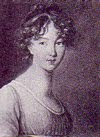This pattern comes from Weldon’s Practical Knitter,
Number 1, First Series (1886). It is also published in Weldon’s Practical
Needlework, Volume 1, Interweave Press, 1999.
The original pattern calls for “Beehive wool, white or any
colour preferred,” “Bone knitting needles No. 10 (modern equivalent 3.50mm/US
4), a crochet needle, (“No.10”) and ribbon for shaping. “The hood can be lined
or not as preferred.”
I knit this hood on the original sized needles with Knit
Picks Palette’s Edamame.
The hood is made up in four sections. First, this strip which
is begun at “the top of the headpiece” and knit until “you can count 43 holes
straight along.” This part ends up looking ridgebacked or ruffled, or even just
crumpled, but measures just over 11” long, flat.
The second part, knit flat or back and forth, is picked up
along the sides and cast off end of the ridgebacked strip.
I had to start this section on three double pointed needles but I
was able to eventually change to two single pointed straight needles when I had
about six inches knit down. This part, when finished, measures 11 ½” down all sides from the
pick-up row of the ridgebacked strip, now pulled almost flat but still a little puffy, by this added section.
The third part is a “curtain” or skirt or long fringe which will be sewn around the bottom of the hood. It measures 18 ½” wide and 8” long from the top flat edge (when straightened out) to the end of a point at the opposite edge.

The fourth part is a strip of lace edging to go round the
face. Instructions for a crocheted edge are included in the pattern but I do
not crochet. I have tried to learn for years, even taking a special class in
crocheting for knitters. I can do many kinds of handwork but I just cannot seem
to get the hang of or follow a pattern or “read” my crochet work. Thus I had to find a knitted edge. In
spite of having finished all of the parts of the hood last year, I spent the
last few months going back and forth with edgings, looking though many of my 19th
century patterns and repeatedly trawling though all of the facsimiles of
Weldon’s, knitting out samples. I finally settled on the No.26 - Wheat-Ear
Pattern from Weldon’s Practical Knitter, Sixth Series – Edgings (1887?) which
is also published in Weldon’s Practical Needlework, Volume 2, Interweave Press,
2000. This one comes out at about one repeat of the pattern to one inch, and
measures just over 2 ½” wide. The facial border of the hood measures 25” so I
suppose that will be the number of repeats although there is a wavy bit around
the middle of the border (the cast-on edge of the ridgebacked strip) which may call for more repeats.

I do think, however, that this hood would really be better
with a crocheted edging as the
slightly heavier crocheted stitches would balance and hold the hood more securely
on the head with hair arranged in the variations of the popular style of the
era as seen in this image from La Mode Illustrée (Dinner Dresses - 1886.)
All quotations are from Weldon’s Practical Needlework,
Volume 1, Interweave Press, 1999




















